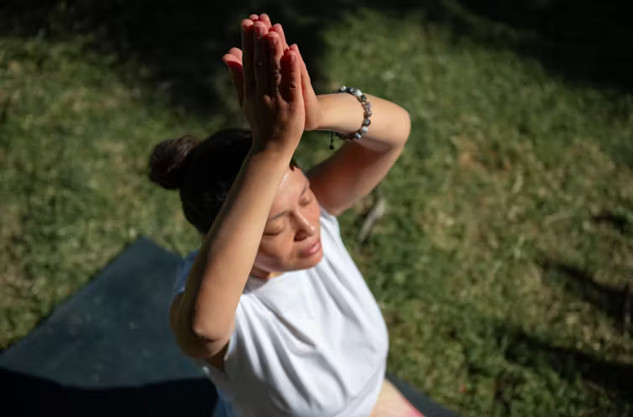From “breathwork recipes” to breathing techniques, many sosiale media en health websites are recommending breathwork to reduce stress.
But breathwork is not new. Rather it is the latest in a long history of breathing techniques such as Pranayama van Indië en Qigong from China. Such practices have been used for thousands of years to promote a healthy mind and body.
The benefits can be immediate and obvious. Try taking a deep breath in through your nose and exhaling slowly. Do you feel a little calmer?
So, what’s the difference between the breathing we do to keep us alive and breathwork?
Breathwork is about control
Breathwork is nie dieselfde nie as other mindfulness practices. While the latter focus on observing the breath, breathwork is about controlling inhalation and exhalation.
Normally, breathing happens automatically via messages from the brain, outside our conscious control. But we can control our breath, by directing the movement of our diaphragm and mouth.
Die diafragma is a large muscle that separates our thoracic (chest) and abdominal (belly) cavities. When the diaphragm contracts, it expands the thoracic cavity and pulls air into the lungs.
Controlling how deep, how often, how fast and through what (nose or mouth) we inhale is the crux of breathwork, from fire breathing humming bee breath.
Breathwork can calm or excite
Even small bits of breathwork can have physical and mental health benefits and complete the stress cycle to avoid burnout.
Calming breathwork includes diaphragmatic (belly) breathing, slow breathing, pausing between breaths, and specifically slowing down the exhale.
In diaphragmatic breathing, you consciously contract your diaphragm down into your abdomen to inhale. This pushes your belly outwards and makes your breathing deeper and slower.
Jy kan ook slow the breath by doing:
-
boks asemhaal (count to four for each of four steps: breathe in, hold, breathe out, hold), or
-
coherent breathing (controlled slow breathing of five or six breaths per minute), or
-
alternatiewe neusgat asemhaling (close the left nostril and breathe in slowly through the right nostril, then close the right nostril and breathe out slowly through the left nostril, then repeat the opposite way).
You can slow down the exhalation specifically by counting, humming or pursing your lips as you breathe out.
In contrast to these calming breathing practices, energising fast-paced breathwork increases arousal. For example, fire breathing (breathe in and out quickly, but not deeply, through your nose in a consistent rhythm) and Leeu se asem (breathe out through your mouth, stick your tongue out and make a strong “haa” sound).
What is happening in the body?
Deep and slow breathing, especially with a long exhale, is the best way to stimulate the vagus nerves. The vagus nerves pass through the diaphragm and are the main nerves of the parasympathetic nervous system.
Simulating the vagus nerves calms our sympathetic nervous system (fight or flight) stress response. This improves mood, lowers the stress hormone Kortisol and helps to regulate emotions and responses. It also promotes more coordinated brain activity, improves immune function and reduces inflammation.
Taking deep, diaphragmatic breaths also has fisiese voordele. This improves blood flow, lung function and exercise performance, increases oxygen in the body, and strengthens the diaphragm.
Stadige asemhaling reduces heart rate and blood pressure and increases heart rate variability (normal variation in time between heart beats). These are linked to better heart health.
Taking shallow, quick, rhythmic breaths in and out through your nose stimulates the sympathetic nervous system. Short-term, controlled activation of the stress response is healthy and develops resilience to stress.
Breathing in through the nose
We are designed to inhale through our nose, not our mouth. Inside our nose are lots of blood vessels, mucous glands and tiny hairs called cilia. These warm and humidify the air we breathe and filter out germs and toxins.
We want the air that reaches our airways and lungs to be clean and moist. Cold and dry air is irritating to our nose and throat, and we don’t want germs to get into the body.
Nasal breathing increases parasympathetic activity and releases nitric oxide, which improves airway dilation and lowers blood pressure.
Consistently breathing through our mouth is nie gesond nie. Dit kan lei tot besoedeling en infeksies reaching the lungs, snoring, sleep apnoea, and tandheelkundige kwessies including cavities and jaw joint problems.
A free workout
Stadige asemhaling – even short sessions at home – can reduce stress, anxiety and depression in the general population and among those with clinical depression or anxiety. Research on breathwork in helping post-traumatic stress disorder (PTSD) is also promising.
Diaphragmatic breathing to improve lung function and strengthen the diaphragm can improve breathing and exercise intolerance in chroniese hartversaking, chroniese obstruktiewe longsiekte en asma. Dit kan ook improve exercise performance en reduce oxidative stress (an imbalance of more free radicals and/or less antioxidants, which can damage cells) after exercise.
A mind-body connection you can access any time
If you feel stressed or anxious, you might subconsciously take shallow, quick breaths, but this can make you feel more anxious. Deep diaphragmatic breaths through your nose and focusing on strong exhalations can help break this cycle and bring calm and mental clarity.
Net 'n paar minute per dag of breathwork can improve your physical and mental health and wellbeing. Daily deep breathing exercises in die werkplek reduce blood pressure and stress, which is important since burnout rates are high.
Bottom line: any conscious control of your breath throughout the day is positive.
So, next time you are waiting in a line, at traffic lights or for the kettle to boil, take a moment to focus on your breath. Breathe deeply into your belly through your nose, exhale slowly, and enjoy the benefits.![]()
Theresa Larkin, Associate professor of Medical Sciences, Universiteit van Wollongong en Judy Pickard, Senior Lecturer, Clinical Psychology, Universiteit van Wollongong
Hierdie artikel is gepubliseer vanaf Die gesprek onder 'n Creative Commons lisensie. Lees die oorspronklike artikel.

Verwante Boeke:
Atoomgewoontes: 'n Maklike en bewese manier om goeie gewoontes op te bou en slegte dinge te breek
deur James Clear
Atomic Habits verskaf praktiese raad om goeie gewoontes te ontwikkel en slegte gewoontes te breek, gebaseer op wetenskaplike navorsing oor gedragsverandering.
Klik vir meer inligting of om te bestel
Die vier neigings: die onontbeerlike persoonlikheidsprofiele wat onthul hoe u u lewe beter kan maak (en ook die lewens van ander mense)
deur Gretchen Rubin
Die Vier Tendensies identifiseer vier persoonlikheidstipes en verduidelik hoe om jou eie neigings te verstaan jou kan help om jou verhoudings, werksgewoontes en algehele geluk te verbeter.
Klik vir meer inligting of om te bestel
Dink weer: die krag om te weet wat u nie weet nie
deur Adam Grant
Think Again ondersoek hoe mense hul gedagtes en houdings kan verander, en bied strategieë om kritiese denke en besluitneming te verbeter.
Klik vir meer inligting of om te bestel
Die liggaam hou die telling: brein, verstand en liggaam in die genesing van trauma
deur Bessel van der Kolk
The Body Keeps the Score bespreek die verband tussen trauma en fisiese gesondheid, en bied insigte oor hoe trauma behandel en genees kan word.
Klik vir meer inligting of om te bestel
Die sielkunde van geld: Tydlose lesse oor rykdom, gierigheid en geluk
deur Morgan Housel
Die Sielkunde van Geld ondersoek die maniere waarop ons houdings en gedrag rondom geld ons finansiële sukses en algehele welstand kan vorm.
























